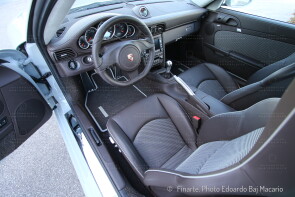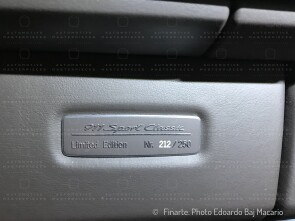
2010 Porsche 911 Sport Classic
ON/OFF
Why am I an Automotive Masterpiece?
L. Limited edition cars
no. 250 manufactured, 212nd built
The Porsche 911 is a two-door, 2+2 high-performance sports car that has been in production since 1963. At the IAA (Frankfurt Motor Show) in September 1963, Porsche presented its much more powerful, larger, and more comfortable successor to the Porsche 356, originally called the 901. After producing 82 units and encountering a trademark dispute with Peugeot, Porsche renamed it the 911 for its market launch in 1964. The design was largely the work of Ferdinand "Butzi" Porsche, son of Ferdinand "Ferry" Porsche, with Erwin Komenda, head of Porsche's car body construction department, also contributing to its development. Its air-cooled six-cylinder boxer engine (1991 cc) delivered 130 hp, enabling an impressive top speed of 210 km/h. In 1966, Porsche introduced the 160 hp 911 S (standing for "Super"), the first model to feature forged alloy wheels from Fuchs. The 911 Targa, with its distinctive stainless steel roll bar, debuted later that same year as the world's first-ever "safety cabriolet." In 1967, the semiautomatic Sportomatic four-speed transmission was added to the lineup. That same year, with the 911 T and later E and S variants, Porsche became the first German manufacturer to meet strict U.S. exhaust emission control regulations. The Porsche 911 gained power as its engine displacement grew, initially to 2.2 liters (1969) and later to 2.4 liters (1971). The 911 S models also received a discreet front bumper spoiler to improve high-speed stability. Weighing just 1050 kg, these models are often regarded as the best classic mainstream 911s. During this period, Porsche developed the S/T for racing, produced in limited numbers between 1970 and 1971. These cars benefited from new FIA rules allowing a two-inch wider track. To accommodate this, the wheel arches were widened for seven-inch front and nine-inch rear wheels. The S/T was offered with engines of either 2466 cc or 2492 cc, producing 270 hp at 8000 rpm. Weight was reduced to 960 kg. The 911 Carrera RS 2.7 of 1972, powered by a 210 hp engine and weighing under 1000 kg, remains a dream car to this day. Its signature "ducktail" spoiler was the world's first rear spoiler on a production vehicle. In 1973, Porsche introduced the RSR, a factory-built racing car based on the 911 chassis. The Porsche 911 remains in production today and has undergone numerous changes over the years. However, it can be broadly categorized into two fundamental series: air-cooled 911s (1963–1997) and water-cooled 911s (from 1998 onwards).
The Porsche 997 is a car produced from 2004 to 2012 as the fifth generation of the 911 model, and the second generation of water-cooled 911s. The 997 “Sport Classic” was launched at the 2009 Internationale Automobil-Ausstellung (IAA) in Frankfurt, celebrating the 25th anniversary of Porsche Exclusive, the customization department where bespoke Porsche vehicles are created for the most demanding customers. Produced in only 250 units based on the 997 Carrera S, the Sport Classic features several technical and stylistic details offered as options on the 997 version, along with some unique features, such as body colors and interior components. The chosen color is Sport Classic Grey, a shade never used before by Porsche, enhanced by a double grey stripe running along the entire body. The rear is particularly "muscular," being 44 mm wider, and there is a clear reference to the 911s of the past: the “ducktail” spoiler with a dual air intake that sits above the custom rear bumper, made to accommodate the new oval chrome exhaust pipes. The roof has a peculiar double-bubble shape. The front bumper, created by the Exclusive department, features a unique front lip and air intakes. Another peculiarity is the chrome badge of the Exclusive department, applied only on the right side, at the height of the turn indicator; this element aims to recall the badge of the Reutter coachbuilders, who built the 356 Speedsters and applied it only on the right side of the 356 models. The specific 19-inch wheels are designed in homage to Fuchs wheels, with gloss black spokes, a chrome rim, and a center cap with a colored Porsche crest. Mechanically, the Sport Classic is equipped with the optional features available for the 997 Carrera: the "X51" kit for the engine, with a new resonance intake system featuring six electronically controlled throttle valves, boosts power to 408 hp, 23 more than the Carrera S, and produces a maximum torque of 420 Nm at 4,200 rpm. For the braking system, the car is fitted with ceramic composite brakes from the prestigious Porsche Ceramic Composite Brake (PCCB) system. The suspension is lowered by 20 mm and equipped with PASM (Porsche Active Suspension Management), an electronic damper control system that constantly adjusts the damping force for each wheel according to road conditions and driving style. Regarding the transmission, the Sport Classic caters to "old-school" sporty users, featuring a six-speed manual transmission and a mechanical limited-slip rear differential; an automatic transmission is not available. For the interior, materials never before used by Porsche were chosen, such as woven leather, an elegant combination of smooth leather and fabric used for the central seat section and door panel inserts, as well as light grey seat profiles. The dashboard, enriched with numerous inserts and additional elements, is finished in natural leather in the "natural espresso" color variant, contrasting with the body color, while the headliner is grey. For some interior details, aluminum was selected as a finish, including the gear lever with a brown gear selection bezel, the instrument surrounds, with the tachometer crossed by two grey lines that echo those on the body. On the passenger-side glove compartment, a chrome plate is applied, indicating the serial number of the model. In 2010, Porsche also produced a 997 Speedster, featuring the mechanics, wheels, and brakes of the Sport Classic.
The 2010 Porsche 911 (997) Sport Classic, chassis no. WP0ZZZ99ZAS794178, is among the last examples produced of the model: it is, in fact, number 212/250. It was purchased new by Saottini Auto SpA, a historic dealership in Brescia that, recognizing the car's rarity, acquired the example and decided to preserve it as a true instant classic among the vehicles chosen for the Saottini Collection. Over ten years, the car covered only 3,000 km, with a single owner, until Beatrice Saottini decided to auction off much of the collection in October 2020, at the 1000 Finarte auction. The car was sold at that time, in like-new condition, complete with special gadgets dedicated to the model, a Porsche Certificate of Origin, and Italian registration and plates. Since then, it has been part of a private collection.




